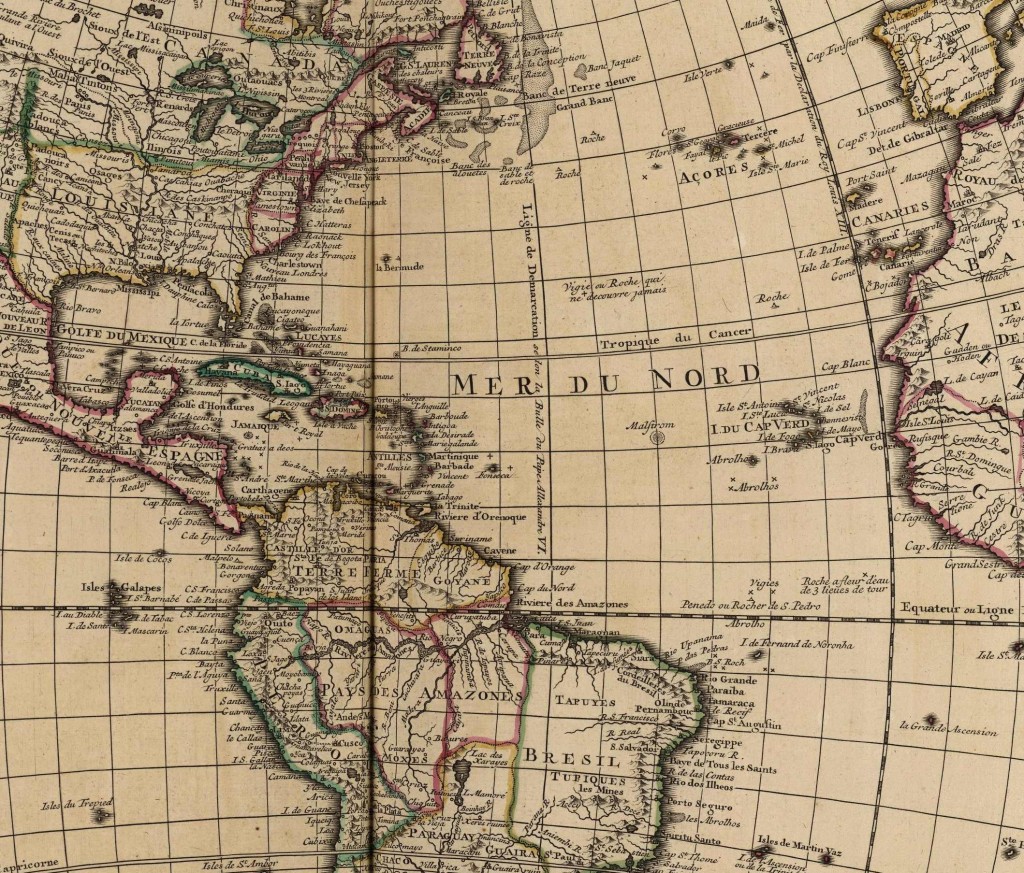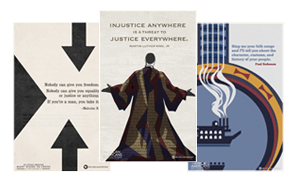Resistance to Slavery ~ Lesson Activities
Lesson Activities
INTRODUCTORY ACTIVITY
1. Distribute “The Americas circa 1750” Student Organizer to each student or group of students. If desired, project a larger version of the map for the class. It is available here under a creative commons license: http://www.davidrumsey.com/luna/servlet/s/82bfdc.
2. Ask the students to locate and circle the following locations on the map:
• The Carolinas through Massachusetts
• Florida
• St. Domingue (currently Haiti)
3. Have the students use their organizer to indicate which of the three locations they identified in step 1 were:
• Colonized by England (The Carolinas through Massachusetts)
• Colonized by Spain (Florida)
• Colonized by France (St. Domingue)
4. Have the students draw arrows to indicate the direction of the Transatlantic trade in African slaves in the 16th-18th centuries. (Slaves traveled from West Africa to locations on the Atlantic coast of the Americas, including New England, Florida, the Caribbean, and Brazil).
5. Explain that although African slaves traveled to various parts of the Americas, the particular ways that slavery was enacted in different parts of the Americas were not the same. One difference was that the ratio of slaves to colonists was different across the colonies. Other differences included the treatment of runaway slaves.
LEARNING ACTIVITY
1. Explain that the conditions of African slavery were very harsh and that naturally, slaves devised many ways to resist slavery. Ask the students to brainstorm a list of ways that slaves might have resisted slavery, and write this list on the board for the class to see. (List should include, at a minimum, running away and violent revolt. Other forms of resistance included self-mutilation, suicide, refusal to work. More subtle forms of resistance that slaves conducted to maintain their cultural identities will be explored later in the lesson).
2. Now focus on “running away” and “violent revolt.” Ask the students whether they think the slaves were always successful when they ran away or tried to revolt. If not, what kinds of factors do the students think would have helped the slaves be successful? (Accept all answers, but guide students to think not only about individual factors like personal strength, choice of timing, and luck, but also about factors at the social/institutional level, such as the number of slaves revolting, and the presence of safe havens for runaways).
3. Explain that they are going to watch some video segments that will show different examples of resistance to slavery across the Americas. For each segment, ask the students to identify what kinds of social and institutional factors contributed to the success and/or failure of the slaves’ efforts at resistance in the example.
4. Play, in turn, the following three video segments. Pause after each segment and have the students discuss the factors that contributed to the success and/or failure of the slaves’ efforts at resistance.
• “St. Augustine, Florida” (The fact that England and Spain were competing with each other for colonial power meant that Spain enacted a policy to grant freedom to runaway slaves from the British colonies. This helped slaves who managed to escape to Florida).
• “Hutchinson’s Revolt” (The slaves were few in number and overwhelmed by the better-armed and better-organized colonial militia).
• “St. Domingue” (There were far more slaves per white colonist in St. Domingue than anywhere else in the New World. This was a major factor contributing to the slaves’ competitive advantage in their successful revolt).
5. Ask the students to return to their “The Americas circa 1750” Student Organizer. Have the students fill in column 3 of their organizer, naming a fact they have learned about the particularity of slavery in each region.
CULMINATING ACTIVITY
1. Explain that not all forms of resistance to slavery took the form of physical escape or forcible revolt. If the students brainstormed any of these more subtle forms of resistance, refer to these now. (e.g. establishment of unique cultural identity; maintenance/creation of specific traditions and rituals).
2. To introduce the next video segment, ask students to use the video as a prompt to think of creative forms of resistance that slaves may have employed to maintain their identities. Tell the students that you will make a collective list of these on the board. Play video segment 4, “Creative Resistance.” After the segment finishes, have the class help make a list on the board of creative forms of resistance (these do not all have to come from the video).
3. Remind the students that in this lesson they have seen examples of African slavery across the Americas: in the British Colonies, Florida, and St. Domingue (Haiti). Ask the students if they think there was any overlap or communication – intellectually or culturally – among African slaves living in different areas of the Americas. (They should remember that the Haitian revolution was strongly influenced by ideas of freedom espoused in the American Revolution, and that communication among different colonies definitely occurred via the shipping trade).
4. Remind the students that almost all African slavery in the New World had ended by the end of the 19th century. Have the students look at the list of forms of “creative resistance” on the board and ask them if they think any of these practices have continued in some form to the present day. If so, how? (A lot of current cultural practices — such as cuisines, religious traditions, music, and holiday traditions — maintain elements from the past. You may note that this is not only true of African-American cultures but of others as well).
5. In the final video segment, students will see an example of a current cultural practice in the United States that is influenced by African slavery in another part of the Americas. Ask the students to identify the tradition and where it originated. Play video segment 5, “Haitian Carnival.” (This explores a tradition in New Orleans that celebrates African Americans’ connection to Haiti).
6. On the back of their “The Americas circa 1750” Student Organizer, have the students write two sentences summarizing two new facts they have learned today about the African slave trade to North America.
7. Collect the “The Americas circa 1750” Student Organizers to assess achievement of the learning objectives.
The Americas circa 1750 Name ___________________
1. Draw arrows on the map to indicate the direction of the trade in African slaves.
2. Circle the three areas listed in the table. Then fill in the second and third columns.
| Colony | Colonized by: | Fact about slavery here: |
| The Carolinas through Massachusetts | ||
| Florida | ||
| St. Domingue |
Find educational resources related to this program - and access to thousands of curriculum-targeted digital resources for the classroom at PBS LearningMedia.
Visit PBS Learning Media







